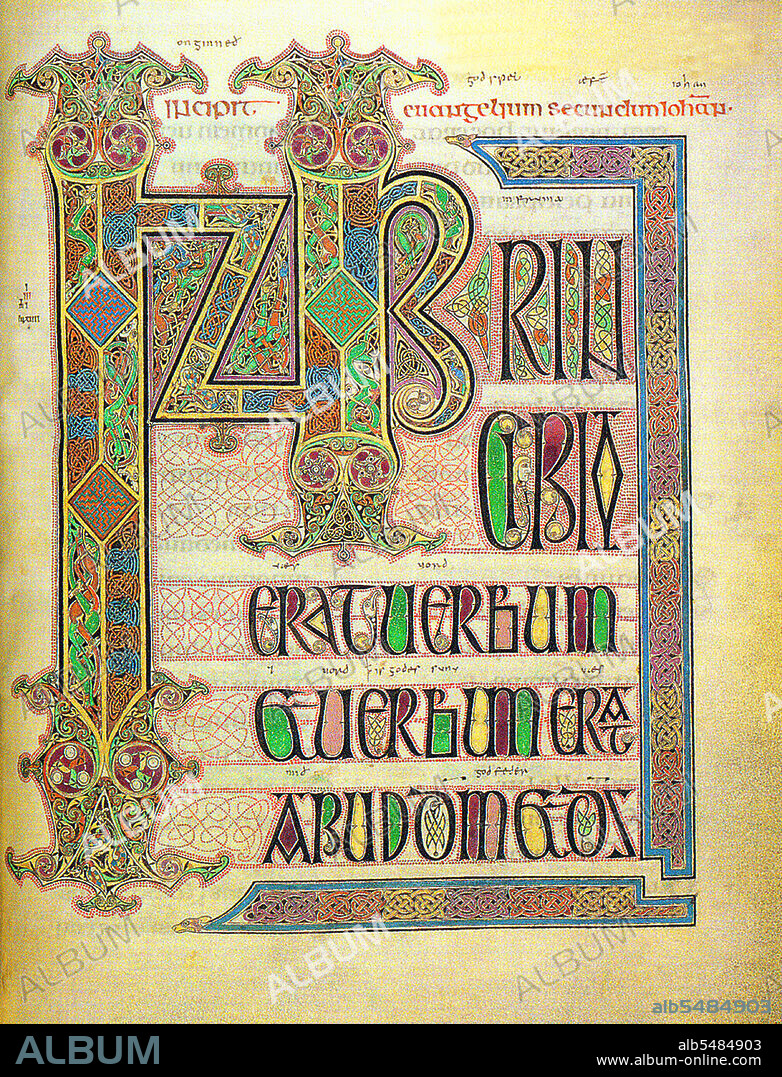alb5484903
The Lindisfarne Gospels, Lindisfarne (Holy Island), c. 700 CE. Folio 211 recto, the incipit from the Gospel of St John.

|
Add to another lightbox |
|
Add to another lightbox |



Title:
The Lindisfarne Gospels, Lindisfarne (Holy Island), c. 700 CE. Folio 211 recto, the incipit from the Gospel of St John.
Caption:
The Lindisfarne Gospels is an illuminated manuscript gospel book produced around the year 700 CE in a monastery on Lindisfarne Island, off the coast of Northumberland. It is now on display in the British Library in London. The manuscript is one of the finest works in the unique style of Hiberno-Saxon or Insular art, combining Mediterranean, Anglo-Saxon and Celtic elements. The Lindisfarne Gospels are presumed to be the work of a monk named Eadfrith, who became Bishop of Lindisfarne in 698 and died in 721. Current scholarship indicates a date around 715, and it is believed they were produced in honour of St. Cuthbert. However, it is also possible that Eadfrith produced them prior to 698, in order to commemorate the elevation of Cuthbert's relics in that year, which is also thought to have been the occasion for which the St Cuthbert Gospel was produced. The Gospels are richly illustrated in the insular style, and were originally encased in a fine leather binding covered with jewels and metals made by Billfrith the Anchorite in the 8th century. During the Viking raids on Lindisfarne, however, this cover was lost, and a replacement was made in 1852. The text is written in insular script. In the 10th century an Old English translation of the Gospels was made: a word-for-word gloss inserted between the lines of the Latin text by Aldred, Provost of Chester-le-Street. This is the oldest extant translation of the Gospels into the English language. The Gospels may have been taken from Durham Cathedral during the Dissolution of the Monasteries, ordered by Henry VIII, and were acquired in the early 17th century by Sir Robert Cotton from Thomas Walker, Clerk of the Parliaments. Cotton's library came to the British Museum in the 18th century, and from there to the British Library in London when this was separated from the British Museum.
Credit:
Album / Pictures From History/Universal Images Group
Releases:
Model: No - Property: No
Rights questions?
Rights questions?
Image size:
3600 x 4717 px | 48.6 MB
Print size:
30.5 x 39.9 cm | 12.0 x 15.7 in (300 dpi)
Keywords:
ANGLO-SAXON • APOSTLES • APOSTOLIC • ART • ARTS • BIBLE NT • BIBLE • BIBLE; • BIBLIA • BIBLICAL • BOOKS • BRITISH • CALLIGRAPHY • CELTIC • CHRIST • CHRISTIAN • CHRISTIANISM • CHRISTIANITY • CHRISTIANS • CRISTIANDAD • CRISTIANISMO • ENGLISH • GREAT BRITAIN • HIBERNO-SAXON • HISTORIA UNIVERSAL • HISTORICAL • HISTORY • HOLY ISLAND • ILLUMINATIONS • INGLES • JESUS CHRIST • JESUS • LEGEND • LINDISFARNE GOSPELS • LINDISFARNE • OLD TESTAMENT • PAINT • PAINTING • PASSION OF CHRIST • PASSION • RELIGION • RELIGION: CHRISTIAN • SAINT CUTHBERT • SCRIPT • TRINITY COLLEGE DUBLIN • WRITING
 Pinterest
Pinterest Twitter
Twitter Facebook
Facebook Copy link
Copy link Email
Email

